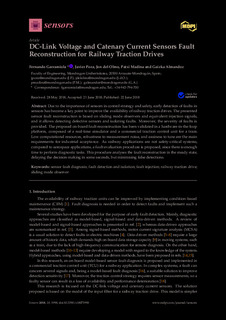Título
DC-Link Voltage and Catenary Current Sensors Fault Reconstruction for Railway Traction DrivesGrupo de investigación
Accionamientos aplicados a la tracción y a la generación de energía eléctricaVersión
Version publicada
Derechos
© 2018 by the authors. Licensee MDPI, Basel, SwitzerlandAcceso
Acceso abiertoVersión del editor
https://doi.org/10.3390/s18071998Publicado en
Sensors Vol. 18. Nº 7. Special Issue: Sensors for Fault Detection. 22 June 2018Editor
MDPI AGPalabras clave
sensor fault diagnosis
fault detection and isolation
fault injection
railway traction drive ... [+]
fault detection and isolation
fault injection
railway traction drive ... [+]
sensor fault diagnosis
fault detection and isolation
fault injection
railway traction drive
sliding mode observer [-]
fault detection and isolation
fault injection
railway traction drive
sliding mode observer [-]
Resumen
Due to the importance of sensors in control strategy and safety, early detection of faults in sensors has become a key point to improve the availability of railway traction drives. The presented senso ... [+]
Due to the importance of sensors in control strategy and safety, early detection of faults in sensors has become a key point to improve the availability of railway traction drives. The presented sensor fault reconstruction is based on sliding mode observers and equivalent injection signals, and it allows detecting defective sensors and isolating faults. Moreover, the severity of faults is provided. The proposed on-board fault reconstruction has been validated in a hardware-in-the-loop platform, composed of a real-time simulator and a commercial traction control unit for a tram. Low computational resources, robustness to measurement noise, and easiness to tune are the main requirements for industrial acceptance. As railway applications are not safety-critical systems, compared to aerospace applications, a fault evaluation procedure is proposed, since there is enough time to perform diagnostic tasks. This procedure analyses the fault reconstruction in the steady state, delaying the decision-making in some seconds, but minimising false detections. [-]
Sponsorship
The authors are thankful to the colleagues from CAF Power and Automation, who provided material and expertise that greatly assisted the research.Colecciones
- Artículos - Ingeniería [745]
El ítem tiene asociados los siguientes ficheros de licencia:






















